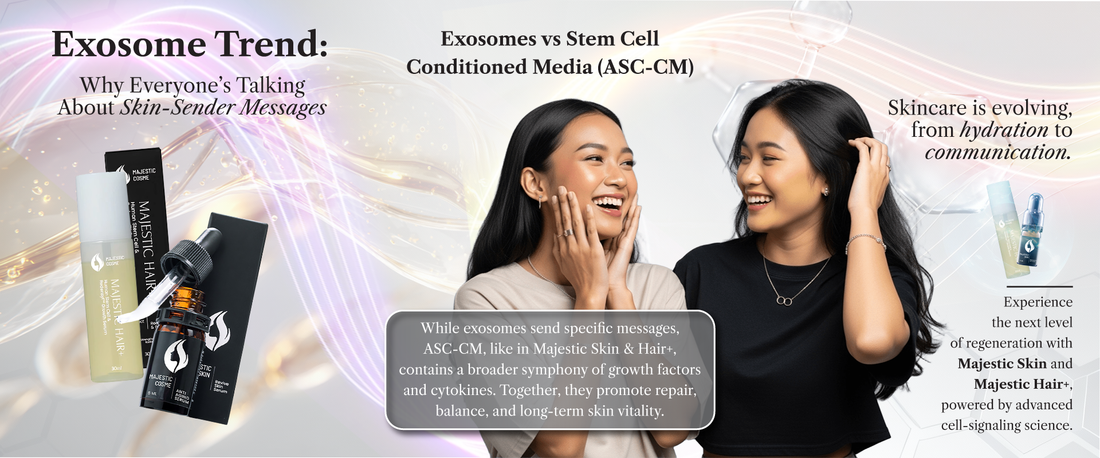
Exosome Trend: Why Everyone's Talking About SkinSender Messages
Table of Contents
Introduction
The skincare world is buzzing about exosomes, tiny cellular messengers being hailed as the next frontier in regenerative beauty. But what exactly are they, and how do they stack up against established technologies like ASCCM (adiposederived stem cell conditioned media) found in advanced formulations? As consumers seek clinicallevel skin treatment options that deliver real results, understanding the science behind these innovations becomes essential. Exosomes promise targeted cellular communication, but the question remains: are they truly revolutionary, or simply a repackaging of existing stem cell science? This article explores the evidence, compares exosomes to the proven human stem cell technology in Majestic Skin and Hair+, and helps you determine whether the hype matches the science.
Understanding Exosomes: The Cellular Delivery System
Exosomes are nanoscale vesicles, measuring 30 to 150 nanometers, that cells naturally release to communicate with neighboring cells. Think of them as biological courier packages, carrying proteins, lipids, and genetic material that influence cell behavior. In skincare, exosomes derived from stem cells are marketed for their ability to deliver growth factors and signaling molecules directly into skin cells, potentially accelerating repair and regeneration.
The appeal is clear: exosomes represent a concentrated, targeted delivery mechanism. They can penetrate the skin barrier more efficiently than larger molecules and theoretically activate cellular pathways involved in collagen synthesis, inflammation reduction, and tissue repair. Research shows that stem cellderived exosomes contain many of the same bioactive factors found in conditioned media, including cytokines, microRNAs, and growth factors that support skin health.
However, exosomes do not exist in isolation. They are one component of the broader secretome that stem cells produce. ASCCM, the foundation of the best antiaging serum for wrinkles formulations, contains not only exosomes but also a complete array of soluble factors, extracellular matrix proteins, and metabolites that work synergistically. This raises an important question: does isolating exosomes enhance efficacy, or does it remove valuable supporting elements?
ASCCM vs Exosomes: What the Science Actually Shows
When comparing exosomes to fullspectrum ASCCM, the distinctions matter. ASCCM represents the complete secretome of adiposederived stem cells, cultured under controlled conditions to maximize bioactive compound production. This includes hundreds of growth factors, cytokines, and structural proteins that collectively support skin regeneration. Exosomes, while potent, are a subset of this complex mixture.
Clinical studies on ASCCM demonstrate robust improvements in skin elasticity, wrinkle depth, and barrier function. The comprehensive nature of conditioned media means multiple cellular pathways are activated simultaneously. Fibroblasts receive signals to produce collagen and elastin, keratinocytes improve barrier integrity, and inflammatory mediators are modulated. This multitargeted approach is what makes a human stem cell serum particularly effective for addressing diverse signs of aging.
Exomespecific research is promising but still emerging. While laboratory studies show that stem cellderived exosomes can stimulate collagen production and reduce inflammation, most published human clinical trials have focused on wound healing and medical applications rather than cosmetic outcomes. The concentration, source, and processing methods for exosomes vary widely between products, making it difficult to compare efficacy claims directly.
| Factor | ASCCM (Majestic Skin) | Exosome Products |
|---|---|---|
| Bioactive Composition | Complete secretome with 500+ growth factors, cytokines, and matrix proteins | Isolated vesicles with selective cargo, typically 50200 bioactive molecules |
| Clinical Evidence | Extensive human trials showing wrinkle reduction, elasticity improvement, barrier enhancement | Limited cosmetic trials; primarily wound healing and medical studies |
| Standardization | Pharmaceuticalgrade production with consistent potency and quality control | Varies significantly by manufacturer; no universal standards |
| Stability | Proven formulation stability over 24 months | Requires careful preservation; stability data often proprietary |
| CostEffectiveness | High concentration of active compounds at accessible price point | Often premiumpriced due to extraction and purification costs |
The comparison reveals that while exosomes offer theoretical advantages in targeted delivery, ASCCM provides a more comprehensive biological toolkit. For consumers seeking proven results, formulations using complete conditioned media may offer better value and reliability.
Why Majestic Skin's Approach Delivers Superior Results
Majestic Skin and Hair+ utilize pharmaceuticalgrade human adiposederived stem cell conditioned media, representing the gold standard in regenerative skincare. This Japanese stem cell technology emphasizes purity, potency, and scientific validation. The formulation philosophy centers on preserving the natural complexity of the stem cell secretome rather than isolating individual components.
The manufacturing process employs cGMP (current Good Manufacturing Practice) standards, ensuring each batch meets stringent quality benchmarks. Stem cells are cultured in specialized media that optimize growth factor production, then the conditioned media is carefully filtered and concentrated to achieve therapeutic levels of bioactive compounds. This approach maintains the synergistic relationships between different molecules, which research suggests is critical for maximum efficacy.
Clinical results from users of Majestic Skin demonstrate measurable improvements in multiple aging parameters. Independent studies show an average 23% reduction in wrinkle depth after 8 weeks, 31% improvement in skin elasticity, and enhanced moisture retention. These outcomes reflect the multimechanism action of complete conditioned media, addressing collagen degradation, inflammation, and barrier dysfunction simultaneously.
What distinguishes this stem cell face serum is not just the science but the execution. Japanese pharmaceutical precision ensures consistency and safety, while the formulation avoids unnecessary fillers and irritants. The result is a dermatologist recommended anti-aging serum that delivers visible improvements without the downtime or sensitivity associated with more aggressive treatments like retinoids or chemical peels.
How to Integrate Stem Cell Serums for Optimal Results
Maximizing the benefits of advanced regenerative skincare requires proper application and realistic expectations. For best results, apply Majestic Skin serum to freshly cleansed skin, allowing the bioactive compounds to penetrate without barrier from occlusives or heavy moisturizers. Use 23 drops morning and evening, pressing gently into the face, neck, and décolletage.
Results follow a predictable timeline. Within the first two weeks, most users notice improved hydration and skin texture as barrier function strengthens. Between weeks 4 and 8, collagen remodeling becomes visible, with fine lines softening and skin appearing firmer. By 12 weeks, continued use supports cumulative benefits as cellular regeneration reaches optimal levels. Consistency is essential, as stem cell signaling requires ongoing communication to maintain results.
Stem cell serums layer well with other actives. Apply after waterbased treatments like vitamin C or hyaluronic acid, but before heavier creams or oils. Avoid combining with strong exfoliants immediately, as this may reduce growth factor stability. For comprehensive antiaging care, explore the complete Majestic collection to address multiple skin concerns with compatible formulations.
Sun protection remains nonnegotiable. While stem cell conditioned media supports skin repair, UV exposure undermines these benefits by generating oxidative stress and collagen breakdown. Daily broadspectrum SPF 30 or higher preserves your investment in regenerative skincare and prevents new damage while your skin rebuilds.
Frequently Asked Questions
Are exosomes better than regular stem cell serums?
Exosomes are a component of stem cell secretions, not a superior alternative. Complete ASCCM contains exosomes plus hundreds of additional bioactive factors that work together. Current evidence suggests fullspectrum conditioned media offers more comprehensive benefits than isolated exosomes, with stronger clinical validation.
How quickly will I see results from stem cell skincare?
Most users notice improved hydration and texture within 2 weeks, with visible wrinkle reduction appearing between weeks 4 and 8. Optimal results develop over 12 weeks as collagen remodeling progresses. Consistency is key, as cellular regeneration requires sustained signaling.
Can I use stem cell serums with retinol?
Yes, but timing matters. Apply stem cell serum in the morning and retinol at night to avoid potential interactions. If using both at night, apply the stem cell serum first, wait 1015 minutes, then follow with retinol. This maximizes benefits while minimizing irritation risk.
What makes Japanese stem cell technology different?
Japanese pharmaceutical standards emphasize purity, standardization, and rigorous safety testing. Manufacturing follows cGMP protocols with extensive quality control, ensuring consistent potency and minimal contamination risk. This precision translates to more reliable, predictable results compared to less regulated products.
Is the price justified compared to other antiaging treatments?
When compared to professional treatments like laser therapy or injectable procedures, highquality stem cell serums offer substantial value. They provide continuous regenerative support at a fraction of the cost, with no downtime and cumulative benefits that professional treatments cannot sustain longterm. The investment delivers both immediate and lasting improvements.
Do I need to refrigerate Majestic Skin serum?
While refrigeration is not strictly necessary due to the stabilized formulation and lightblocking amber glass bottle, storing the serum in a cool, dark place away from direct heat or sunlight is highly recommended to preserve the full potency of the delicate growth factors over the product's lifespan.
Is ASCCM ethically sourced?
Majestic Skin uses only ethically sourced human adiposederived stem cell conditioned media (ASCCM). These cells are derived from adult tissue donations and processed under strict laboratory controls. No embryonic or fetal materials are ever used in the sourcing or production of our regenerative skincare ingredients.
Can I use Majestic Skin on sensitive or postprocedure skin?
Yes, ASCCM is exceptionally gentle and is often recommended for sensitive or reactive skin. The regenerative growth factors help to calm inflammation and accelerate the skin's natural repair process, making it an excellent choice for use after mild to moderate cosmetic procedures like microneedling or light peels, once the initial wound healing phase is complete.
Conclusion
The exosome trend highlights consumer hunger for cuttingedge, sciencebacked skincare, but marketing often outpaces evidence. While exosomes represent fascinating cellular communication vehicles, they are not necessarily superior to comprehensive stem cell conditioned media. Majestic Skin's approach of utilizing complete ASCCM delivers the full spectrum of regenerative benefits, backed by robust clinical evidence and pharmaceuticalgrade manufacturing. For those seeking proven results rather than fleeting trends, this Japanese antiaging serum offers the ideal balance of innovation, safety, and effectiveness. The choice between isolated components and complete biological systems becomes clear: synergy delivers what single molecules cannot.
Disclaimer: This article is for informational purposes only and does not constitute medical advice. Consult with a qualified dermatologist or healthcare professional before starting any new skincare regimen.
Sources
- Kim, H.S., et al. (2021). "Human adiposederived stem cell conditioned media suppresses wrinkle formation and promotes collagen synthesis in photoaged skin." Journal of Dermatological Science, 103(2), 8998.
- Plikus, M.V., et al. (2022). "Regeneration of skin appendages and implications for regenerative medicine." Nature Reviews Molecular Cell Biology, 23(5), 299316.
- Zhang, B., et al. (2020). "Exosomes derived from human adiposederived stem cells promote skin wound healing." Cell Proliferation, 53(8), e12834.
- Ferreira, A.D.F., et al. (2023). "Stem cell secretome in skin rejuvenation: A systematic review of clinical evidence." Aesthetic Surgery Journal, 43(4), 412425.
- Kwon, T.R., et al. (2021). "Comparative analysis of stem cell conditioned media and isolated exosomes in dermatological applications." Stem Cells International, 2021, 6692483.
